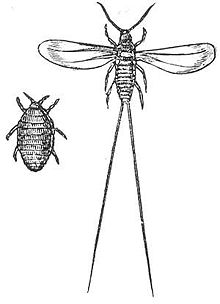
Back دودة قرمزية Arabic دوده قرمزيه ARZ Koşenil yastıcası Azerbaijani Кашаніль Byelorussian Cochineal BS Cotxinilla de la figuera de moro Catalan Dactylopius coccus CEB Červec nopálový Czech Cochenillelus Danish Cochenilleschildlaus German
| Cochineal | |
|---|---|

| |
| Female (left) and male (right) cochineals | |
| Scientific classification | |
| Domain: | Eukaryota |
| Kingdom: | Animalia |
| Phylum: | Arthropoda |
| Class: | Insecta |
| Order: | Hemiptera |
| Suborder: | Sternorrhyncha |
| Family: | Dactylopiidae |
| Genus: | Dactylopius |
| Species: | D. coccus
|
| Binomial name | |
| Dactylopius coccus Costa, 1835
| |
| Synonyms | |
|
Coccus cacti Linnaeus, 1758 | |
The cochineal (/ˌkɒtʃɪˈniːl, ˈkɒtʃɪniːl/ KOTCH-ih-NEEL, -neel, US also /ˌkoʊtʃɪˈniːl, ˈkoʊtʃɪniːl/ KOH-chih-;[1] Dactylopius coccus) is a scale insect in the suborder Sternorrhyncha, from which the natural dye carmine is derived. A primarily sessile parasite native to tropical and subtropical South America through North America (Mexico and the Southwest United States), this insect lives on cacti in the genus Opuntia, feeding on plant moisture and nutrients. The insects are found on the pads of prickly pear cacti, collected by brushing them off the plants, and dried.

The insect produces carminic acid that deters predation by other insects. Carminic acid, typically 17–24% of dried insects' weight, can be extracted from the body and eggs, then mixed with aluminium or calcium salts to make carmine dye, also known as cochineal. Today, carmine is primarily used as a colorant in food and in lipstick (E120 or Natural Red 4).
Carmine dye was used in the Americas for coloring fabrics and became an important export good in the 16th century during the colonial period. Production of cochineal is depicted in the Codex Osuna (1565).[2] After synthetic pigments and dyes such as alizarin were invented in the late 19th century, use of natural-dye products gradually diminished. Fears over the safety of artificial food additives renewed the popularity of cochineal dyes, and the increased demand has made cultivation of the insect profitable again,[3] with Peru being the largest producer, followed by Mexico, Chile, Argentina and the Canary Islands.[4]
Other species in the genus Dactylopius can be used to produce "cochineal extract", and are extremely difficult to distinguish from D. coccus, even for expert taxonomists; the scientific term D. coccus and the vernacular "cochineal insect" are sometimes used, intentionally or casually, and possibly with misleading effect, to refer to other species.[note 1]
- ^ Wells, John C. (2008). Longman Pronunciation Dictionary (3rd ed.). Longman. ISBN 978-1-4058-8118-0.
- ^ Nahuatl Community: Cultivation of cacti for the production of the red dye cochineal. Codex Osuna: Seven documents presented as evidence against the Viceroy Luis de Velasco during the 1563-1566 inquiry by Jeronimo de Valderrama. Folio 500v. Biblioteca Nacional, Madrid. 1565. p. 258.
- ^ Liberato Portillo Martinez; Ana Lilia Vigueras Guzmán (1998-04-15). "Natural Enemies of Cochineal (Dactylopius coccus Costa): Importance in Mexico". Journal of the Professional Association for Cactus Development. 3. Retrieved 28 March 2022.[permanent dead link]
- ^ Cite error: The named reference
Millerwas invoked but never defined (see the help page).
Cite error: There are <ref group=note> tags on this page, but the references will not show without a {{reflist|group=note}} template (see the help page).